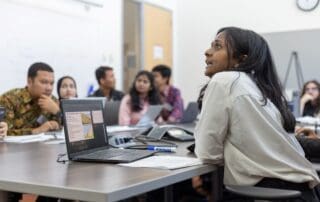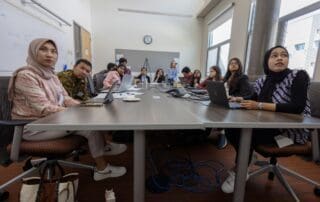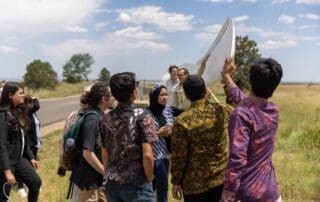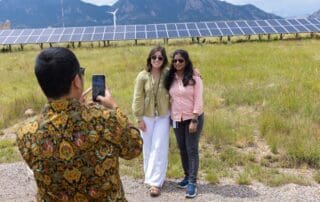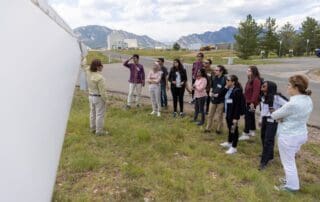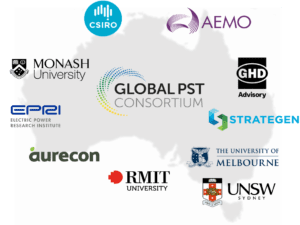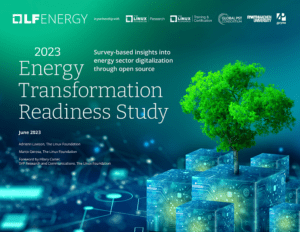This quarterly newsletter highlights recent projects, partnerships, and resources
from the Global Power System Transformation (G-PST) Consortium.
Pay Now or Pay Later: Achieving a Century’s Worth of Energy Transition Progress This Decade
One of the things I do for fun with my limited free time is run on the trails around my hometown of Flagstaff, Arizona. Earlier this summer, the organizers of a 50-kilometer race I am running later in the year sent out a nice email to see how everyone’s training for the race was going, with the ominous message: “Pay Now or Pay Later.”
And so, nowhere near as often as I should, I’ve been getting up before dawn to “Pay Now” and do the hardest 1-hour run I can find, from the Humphrey’s Peak trailhead at 9,300′, approximately 3.75 miles up to 11,400′ where the trail goes from difficult to unrunnable (for me), and then I turn around and proceed at about the same pace back downhill to the start.
What does this have to do with our work at the Global Power System Transformation Consortium, you might be wondering? I was thinking, while out on this run the other day, that there is a corollary here with the critical and urgent work G-PST is doing trying to accelerate the energy transition–so we don’t all “Pay Later.”
We are not joking at G-PST when we say we must make a century’s worth of power system progress in this decade.
If we look at the weather, emissions, and infrastructure deployment data, it’s clear that even the significant efforts and investments being made today are not sufficient. We desperately need to be making faster headway, and at greater scale, on the technical challenges that power system operators are facing as they keep our grids running in this brave new world. We can all see that the technical problems and background conditions are becoming more complex every season. Delivering on climate targets means devoting tremendous, unprecedented resources to solving problems now so that we can execute the fastest, smoothest energy transition possible for everyone in the world and avoid the worst effects of climate change–Pay Now or Pay Later.
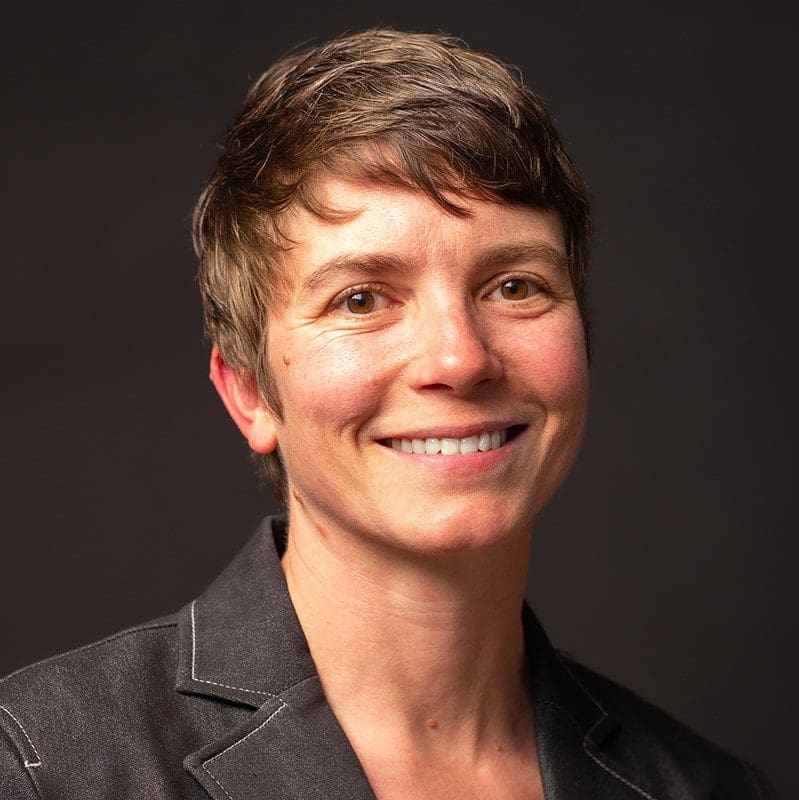 Figuring out how to develop and scale technical solutions for the energy transition keeps me up at night and busy all day, but it’s the single most important thing we can do for the next generation. We must accelerate progress on the technical problems that stand in the way of operating a fully decarbonized power sector.
Figuring out how to develop and scale technical solutions for the energy transition keeps me up at night and busy all day, but it’s the single most important thing we can do for the next generation. We must accelerate progress on the technical problems that stand in the way of operating a fully decarbonized power sector.
If you or someone you know could be a technical contributor or support G-PST’s work, have them join us by reaching out directly at Globalpst@nrel.gov or through our website’s Get Involved page.
Dr. Karin Wadsack
Director, G-PST Consortium Secretariat
Featured News
Women in Power System Transformation 2023 Internship Program Draws to a Close
The Electric Power Research Institute (EPRI) and the National Renewable Energy Laboratory (NREL) welcomed eight undergraduate and graduate students for a 12-week internship program where interns participated in research, training, mentorship, and networking opportunities.
The interns’ research included topics such as electromagnetic transient modeling and VRE grid integration modeling. This technical work was complemented with networking events such as technology symposiums, a “coffee chat” series where interns and experts informally shared and asked career questions, and other opportunities for the interns to engage with industry professionals and deepen their understanding of power system operations.
“[Through Women in PST], I was introduced to grid-forming technologies during my summer at NREL and now it happens to be the core of my PhD work. The program helped me find what I was passionate about. My mentor introduced me to dozens of professionals doing cutting edge research in the field. Interactions with these inspiring individuals helped me get to the place where I am now.” – 2022 internship cohort participant
The 2023 internship cohort also visited NREL’s facilities for hands-on exploration of innovative renewable energy technologies and collaboration with researchers and practitioners at the forefront of clean energy integration. During the week-long visit to NREL, the interns were joined by a cohort from Indonesia’s system operator, PLN, who were participating in a parallel fellowship program at the California Independent System Operator.
Together, the two groups took part in the Self-Empowerment and Equity for Change (SEE Change) workshop, hosted by Johns Hopkins University instructors. The SEE Change program aims to provide participants with an introductory overview of positive psychology tools to unlock leadership potential in the clean energy sector. This curriculum focuses on key areas such as challenging biases, reframing limiting beliefs, and honing negotiation skills, among other critical topics.
Please join us in congratulating the 2023 cohort of Women in PST interns on all their success and efforts throughout this program!
- Celia Doyle, Johns Hopkins University, EPRI
- Jemima Hurley, University College Dublin, EPRI
- Alison Kelley, University College Dublin, EPRI
- Chandinee Chandrasekaran, University of Colorado Boulder, EPRI
- Andreas Uhrich-Lorence, Missouri University of Science and Technology, EPRI
- Mayuri Roy Choudhury, Arizona State University, EPRI
- Mahitha Pillodi, University of Wisconsin Madison, NREL
- Salma Bennai, National Engineering School of Tunis, Tunisia, NREL.
Learn more about the Women in PST initiative and its activities.
G-PST and CSIRO Publish Progress on Key Research for Australia’s Energy Transition
Australia, like many countries around the world, is undergoing a power system transformation to adapt to renewable energy integration and combat the effects of climate change. The country has pursued a particularly aggressive strategy that has made it a model for one of the fastest transformations around the world. But Australia’s power system presents a series of unique challenges, including complex grid interconnection across the country’s wide landscape and end users supplying energy back to the grid through rooftop solar.
In collaboration with the Commonwealth Scientific and Industrial Research Organisation (CSIRO), Australia’s national science agency, G-PST is working on a comprehensive “Research Roadmap” that identifies and explores the research required to advance Australia’s transition to a more secure, affordable, and decarbonized electricity system. The Australian Roadmap ensures these unique challenges will be addressed to remove potential roadblocks from preventing the necessary transformation in the electricity system.
Launched in 2022, Stage 1 of the Research Roadmap identified the intended outcomes of nine individual research topics, including:
- Inverter design
- Stability tools and methods
- Control room of the future
- Planning
- Restoration and Black Start
- Services
- Architecture
- Distributed Energy Resources
- Distributed Energy Resources and Stability.
Released in July 2023, the Stage 2 summary reports encompass key findings and progress updates from the research programs. Individual reports from each of the project partners, outlining the work completed to date, the remaining knowledge gaps, and the high-priority tasks to be delivered in the short term, have also been published. Six of the project themes are common to G-PST, while three (Reports 7, 8, and 9) have been designed specifically for the Australian energy context.
G-PST and CSIRO’s research is already bolstering Australia’s impressive renewable energy integration and will continue to provide insights on cutting-edge topics throughout the country’s power system transformation. This research program is anticipated to take 3 to 5 years to complete. Stage 3 is targeted to be complete in 2024.
Learn more about this multiyear research initiative.
Workshop Series Explores Resource Adequacy
Ensuring resource adequacy is top of mind for power system operators. As demand and generation transform amid broader decarbonization, climate, and electrification trends, how power systems assess adequacy risk is evolving rapidly.
One outcome of G-PST’s in-person London workshop in November 2022 was identifying the need to host more events to bring together international perspectives to address the resource adequacy challenges voiced by system operators. For this reason, G-PST developed a series of workshops to comprehensively explore resource adequacy.
EPRI hosted the first workshop, held virtually, on August 9. It focused on sharing lessons and insights from industry-leading resource adequacy assessments for decarbonized grids as well as understanding what resource adequacy looks like across different decarbonization trajectories.
NREL hosted the second workshop, also virtually, on August 22. This second workshop focused on the intersection of resource adequacy and wholesale market design and what market mechanisms are needed to incentivize resource adequacy as energy systems continue to evolve.
Both workshops were jointly organized by a committee with members from EPRI, NREL, Johns Hopkins University, German Institute for Economic Research, and Imperial College London.
The takeaways from these two virtual workshops fed into an in-person event in Washington, D.C. on September 7, where the goal was to develop a set of possible solutions for how to move forward with improved resource adequacy and market approaches. These solutions and the outcomes of this workshop series will eventually be shared via a published journal article.
Access the EPRI workshop’s presentation materials and recording.
Enhancements to Open-Source Tools Portal Underway

G-PST’s Open Tools and Data Pillar developed an open-source tool portal to help filter, visualize, and identify open-source power systems software capabilities. This portal is a practice-oriented resource aimed at making it easier for system operators, planners, and modelers to find useful tools for managing power systems with high shares of variable renewable energy, such as wind and solar.
G-PST’s team is currently updating the open tools portal to make it easier to find information about different categories of software that can be used for different kinds of analysis (for example, capacity expansion planning vs. production cost modeling vs. power flow and dynamics).
With the new site, users will be able to quickly identify linkages and compatibilities between different tools, other software they depend on, developers, input and output data formats, and software licenses, while making it easier for tool developers and other contributors to provide information to be included in the site.
In addition to the human-readable interface provided by the portal web site, the underlying information used to populate the site will be published in a machine-readable format for researchers and analysts to study and visualize—an open dataset of open tools. The updates will also make it easier and less error-prone to publish updates to the site whenever new content is available. The new site should be live by the end of November 2023.
Explore the current portal. Reach out to Globalpst@nrel.gov if you would like to provide feedback!
2023 Energy Transformation Readiness Study Provides Insights Into Energy Sector Digitalization
As more power system operators increase variable renewable energy generation, they also face new challenges and opportunities for managing an evolving and complex energy system. Digitalizing power system operation will be a key solution to manage the emerging dynamics that come with renewable energy sources.
A study released by G-PST’s partners at the Linux Foundation Energy (LF Energy) examines the use of open-source software in power system digitalization. LF Energy’s survey-based research explores the adoption of open-source technology stacks vital to achieving climate targets, provides actionable insights stemming from the state of digital transformation readiness among energy stakeholders, and identifies existing gaps in educational tooling.
The study finds that energy stakeholders are on the path of digital transformation and are keen to adopt open-source technology. Although intentions and first steps are visible in the sector, industry-wide full adoption and magnified contribution to open source is still on the way. The training and upskilling of the energy sector workforce will play a crucial role in this effort.
Meet the Team: Julia Matevosyan, Energy Systems Integration Group
 Julia Matevosyan is the Chief Engineer at the Energy Systems Integration Group (ESIG). She has more than 20 years of experience in the power industry. Prior to joining ESIG, Matevosyan was the Lead Planning Engineer of the Electric Reliability Council of Texas (ERCOT). In her time with ERCOT, she worked on adequacy of system inertial response, system flexibility, frequency control, and performance issues related to high penetration levels of inverter-based generation and ancillary services market design. Julia received her BSc from Riga Technical University in Latvia, and her MSc and Ph.D. from the Royal Institute of Technology (KTH) in Sweden.
Julia Matevosyan is the Chief Engineer at the Energy Systems Integration Group (ESIG). She has more than 20 years of experience in the power industry. Prior to joining ESIG, Matevosyan was the Lead Planning Engineer of the Electric Reliability Council of Texas (ERCOT). In her time with ERCOT, she worked on adequacy of system inertial response, system flexibility, frequency control, and performance issues related to high penetration levels of inverter-based generation and ancillary services market design. Julia received her BSc from Riga Technical University in Latvia, and her MSc and Ph.D. from the Royal Institute of Technology (KTH) in Sweden.
In her Q&A, Julia shares about her career trajectory, her role and work within G-PST, how G-PST is helping build connections between the research community and system operators, and more.
Events and Resources
In case you missed any, access all the past quarter’s trainings and workshops.
Transforming the Global Power Sector: Open Data and Tools for Renewable Energy Integration
In a two-part training, expert speakers introduced open-source data platforms and tools that support planning for grid integration of variable renewable energy. The speakers discussed production cost modeling tools for power sector planning and demonstrate production cost modeling development, supported by an open-source data and code package for side-by-side learning. Tools covered included the Sienna applications, the System Advisor Model, and the Renewable Energy Data Explorer.
G-PST/ESIG Webinar Series: Cloudy with a Chance of Blackouts or Full of Hot Air
This presentation focused on the evaluation of weather events in long-term power system planning and the changing resource adequacy needs resulting from the energy transition. Discussion included recommendations for incorporating weather patterns into electrification load profiles to develop accurate future electricity demand estimates. Overall, the presentation aimed to provide power system planners with practical recommendations and insights to navigate weather-related risks and the energy transition, ensuring the development of a reliable, resilient, and sustainable energy system.
G-PST/ESIG Webinar Series: Distributed ReStart–Restoration of the Future
The Distributed ReStart project launched in 2019 as a partnership between National Grid Electricity System Operator, SP Energy Networks, and TNEI (a specialist energy consultancy). The project is a world-first initiative, exploring how distributed energy resources such as biomass, wind, hydro, solar, or batteries can be used to restore power to the electricity network in the unlikely event of a blackout—a process known as system restoration or black start. The webinar covered details of the live trials undertaken over the last few years, coupled with information on the necessary organizational systems, telecoms, procurement, and compliance activities needed to transition to business-as-usual.
In Ireland and Northern Ireland, a small synchronous power system with limited high-voltage DC interconnection, energy transition challenges are more pronounced, and new holistic approaches have been developed to steadily increase the instantaneous share of non-synchronous resources (mostly wind) to the current level of 75%. One of the key contributors to this success story has been the implementation of look-ahead security assessment capabilities as decision support tools in the control rooms. This functionality identifies potential instabilities in advance of the issues manifesting in real time and enables timely implementation of the required measures to meet the operational security criteria. This webinar shared EirGrid’s experience in the development and operation of look-ahead functionality for steady-state and dynamic security assessment and its integration in the control room environments.
Join IRENA’s 2023 Innovation Week!
The International Renewable Energy Agency (IRENA) extended an opportunity to G-PST’s partners and audience to express interest in participating in IRENA’s Innovation Week. This conference is taking place from September 25-28 in Bonn, Germany, and brings together leaders, experts, industry representatives, academics, and policy makers to discuss cutting-edge innovations that can support and accelerate the global energy transition. The insights shared during IRENA Innovation Week will serve to identify priority actions to fully unlock the potential of renewable energy applications in end-use sectors, and to inform the Agency’s recommendations and advice to its members and the wider community.
- For more information, visit the Innovation Week website: innovationweek.irena.org.
- Request an invitation at: innovationweek.irena.org/#Request-for-Invitation.

